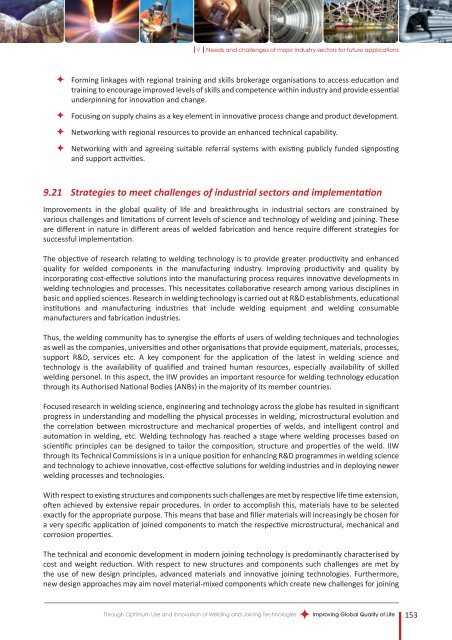Improving Global Quality of Life
Improving Global Quality of Life
Improving Global Quality of Life
You also want an ePaper? Increase the reach of your titles
YUMPU automatically turns print PDFs into web optimized ePapers that Google loves.
9 Needs and challenges <strong>of</strong> major industry sectors for future applications<br />
Forming linkages with regional training and skills brokerage organisations to access education and<br />
training to encourage improved levels <strong>of</strong> skills and competence within industry and provide essential<br />
underpinning for innovation and change.<br />
Focusing on supply chains as a key element in innovative process change and product development.<br />
Networking with regional resources to provide an enhanced technical capability.<br />
Networking with and agreeing suitable referral systems with existing publicly funded signposting<br />
and support activities.<br />
9.21 Strategies to meet challenges <strong>of</strong> industrial sectors and implementation<br />
Improvements in the global quality <strong>of</strong> life and breakthroughs in industrial sectors are constrained by<br />
various challenges and limitations <strong>of</strong> current levels <strong>of</strong> science and technology <strong>of</strong> welding and joining. These<br />
are different in nature in different areas <strong>of</strong> welded fabrication and hence require different strategies for<br />
successful implementation.<br />
The objective <strong>of</strong> research relating to welding technology is to provide greater productivity and enhanced<br />
quality for welded components in the manufacturing industry. <strong>Improving</strong> productivity and quality by<br />
incorporating cost-effective solutions into the manufacturing process requires innovative developments in<br />
welding technologies and processes. This necessitates collaborative research among various disciplines in<br />
basic and applied sciences. Research in welding technology is carried out at R&D establishments, educational<br />
institutions and manufacturing industries that include welding equipment and welding consumable<br />
manufacturers and fabrication industries.<br />
Thus, the welding community has to synergise the efforts <strong>of</strong> users <strong>of</strong> welding techniques and technologies<br />
as well as the companies, universities and other organisations that provide equipment, materials, processes,<br />
support R&D, services etc. A key component for the application <strong>of</strong> the latest in welding science and<br />
technology is the availability <strong>of</strong> qualified and trained human resources, especially availability <strong>of</strong> skilled<br />
welding personel. In this aspect, the IIW provides an important resource for welding technology education<br />
through its Authorised National Bodies (ANBs) in the majority <strong>of</strong> its member countries.<br />
Focused research in welding science, engineering and technology across the globe has resulted in significant<br />
progress in understanding and modelling the physical processes in welding, microstructural evolution and<br />
the correlation between microstructure and mechanical properties <strong>of</strong> welds, and intelligent control and<br />
automation in welding, etc. Welding technology has reached a stage where welding processes based on<br />
scientific principles can be designed to tailor the composition, structure and properties <strong>of</strong> the weld. IIW<br />
through its Technical Commissions is in a unique position for enhancing R&D programmes in welding science<br />
and technology to achieve innovative, cost-effective solutions for welding industries and in deploying newer<br />
welding processes and technologies.<br />
With respect to existing structures and components such challenges are met by respective life time extension,<br />
<strong>of</strong>ten achieved by extensive repair procedures. In order to accomplish this, materials have to be selected<br />
exactly for the appropriate purpose. This means that base and filler materials will increasingly be chosen for<br />
a very specific application <strong>of</strong> joined components to match the respective microstructural, mechanical and<br />
corrosion properties.<br />
The technical and economic development in modern joining technology is predominantly characterised by<br />
cost and weight reduction. With respect to new structures and components such challenges are met by<br />
the use <strong>of</strong> new design principles, advanced materials and innovative joining technologies. Furthermore,<br />
new design approaches may aim novel material-mixed components which create new challenges for joining<br />
Through Optimum Use and Innovation <strong>of</strong> Welding and Joining Technologies<br />
<strong>Improving</strong> <strong>Global</strong> <strong>Quality</strong> <strong>of</strong> <strong>Life</strong><br />
153
















